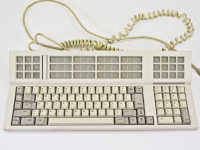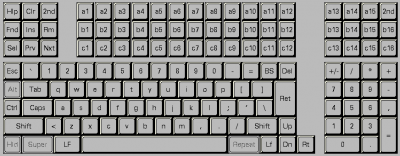Driver:InterPro: Difference between revisions
Pmackinlay (talk | contribs) |
Pmackinlay (talk | contribs) (→Models) |
||
| Line 8: | Line 8: | ||
== Hardware == | == Hardware == | ||
=== Models === | === Models === | ||
The InterPro | The InterPro range consists of 5 distinct generations or families, named after gemstones. The system models within each family share a common architecture and features, usually differing only by CPU type and clock speed. | ||
{| class="wikitable" | {| class="wikitable" | ||
|+ style="caption-side:bottom;"|''System Families'' | |||
! Year | ! Year | ||
! Family | ! Family | ||
| Line 45: | Line 46: | ||
|- | |- | ||
|} | |} | ||
For Emerald, Turquoise and Sapphire systems, the four-digit model number encodes some aspects of the original system configuration, and breaks down as follows. | |||
{| class="wikitable" | |||
|+ style="caption-side:bottom;"|''Model Numbering'' | |||
! Position | |||
! Purpose | |||
! Values | |||
|- | |||
| 1 | |||
| Case | |||
| 2=desktop, 6=minicase | |||
|- | |||
| 2 | |||
| CPU | |||
| 0=C300, 4=C4T, 6=C4, 5/8/7=C4I | |||
|- | |||
| 3 | |||
| Graphics | |||
| 0=none, 3=MMG, 5=GTDB, 4=EDGE-1, 8=EDGE-2 | |||
|- | |||
| 4 | |||
| Backplane | |||
| 0=standard, 5/7/9=? | |||
|- | |||
|} | |||
As examples using this encoding, an InterPro 2020 is a desktop C300 system fitted with MMG graphics, while an InterPro 6880 is a minicase C4I system with EDGE-2 graphics. Systems configured without graphics are typically fitted with a serial terminal, and branded InterServe rather than InterPro. This model numbering and branding applies to the system cases, but of course changing graphics options will cause a system's software-identified model number to change. | |||
=== Cards === | === Cards === | ||
Revision as of 10:57, 17 July 2018
Intergraph InterPro
The Intergraph InterPro is a range of computers featuring the CLIPPER processor, and running CLIX, a port of UNIX System V release 3.1.
Status
The MAME driver for the InterPro is a work in progress, and is currently capable of booting and running the CLIX operating system and some software for the InterPro model 2020 configuration.
Hardware
Models
The InterPro range consists of 5 distinct generations or families, named after gemstones. The system models within each family share a common architecture and features, usually differing only by CPU type and clock speed.
| Year | Family | Models | CPU | I/O Processor |
|---|---|---|---|---|
| 1986 | Amethyst | 32C/100/200/300 | C100 | 80186 |
| 1988 | Topaz | 3000/4000/5000 | C300/C300Plus | 80386 |
| 1990 | Emerald | 6000/6100/6200/6500/6600 | C300/C300Plus/C4 | |
| 1990 | Turquoise | 2000 | C300 | |
| 1992 | Sapphire | 2400/2500/2700/2800/6400/6700/6800 | C4T/C4I |
For Emerald, Turquoise and Sapphire systems, the four-digit model number encodes some aspects of the original system configuration, and breaks down as follows.
| Position | Purpose | Values |
|---|---|---|
| 1 | Case | 2=desktop, 6=minicase |
| 2 | CPU | 0=C300, 4=C4T, 6=C4, 5/8/7=C4I |
| 3 | Graphics | 0=none, 3=MMG, 5=GTDB, 4=EDGE-1, 8=EDGE-2 |
| 4 | Backplane | 0=standard, 5/7/9=? |
As examples using this encoding, an InterPro 2020 is a desktop C300 system fitted with MMG graphics, while an InterPro 6880 is a minicase C4I system with EDGE-2 graphics. Systems configured without graphics are typically fitted with a serial terminal, and branded InterServe rather than InterPro. This model numbering and branding applies to the system cases, but of course changing graphics options will cause a system's software-identified model number to change.
Cards
Keyboard


Configuration
Machine configuration